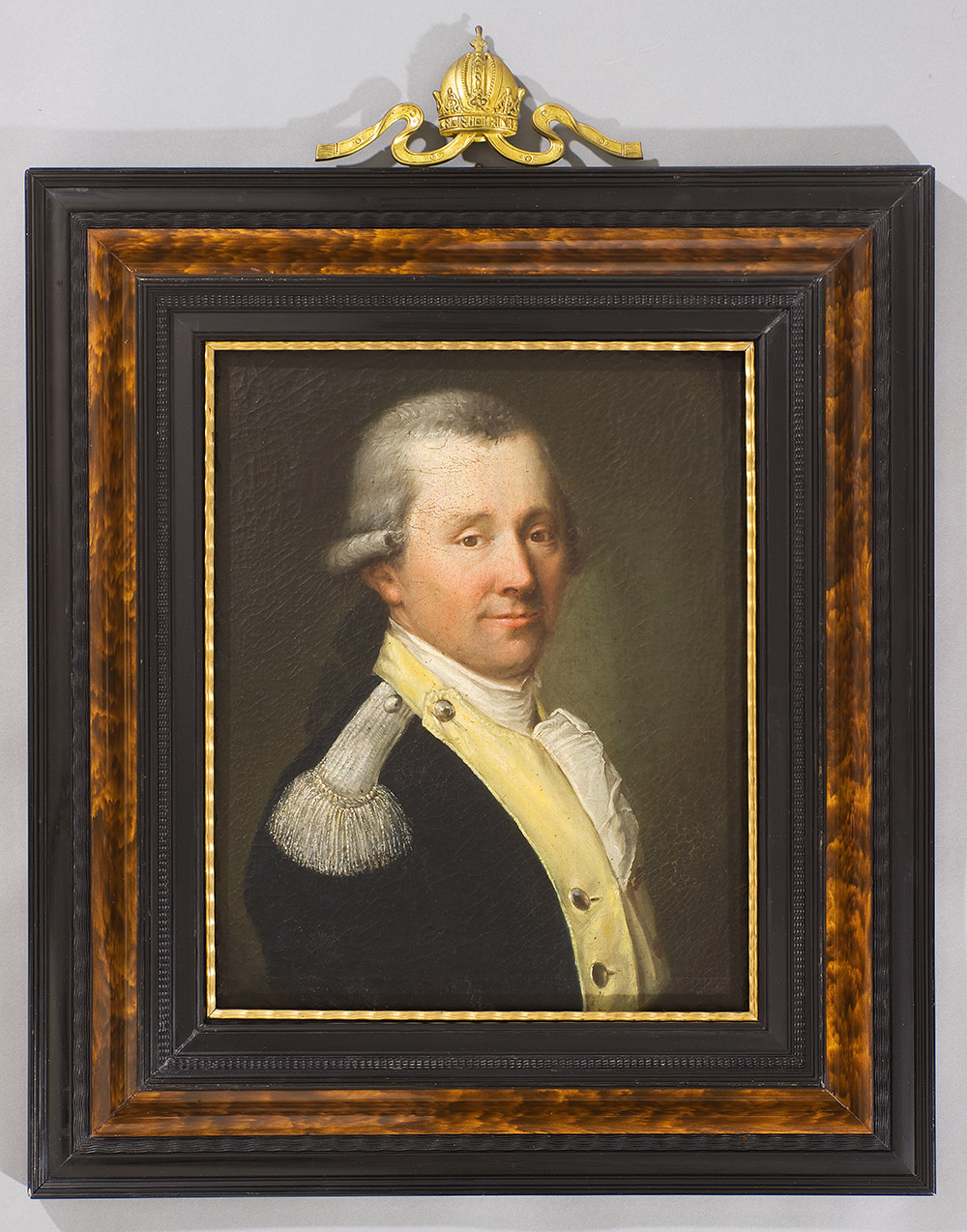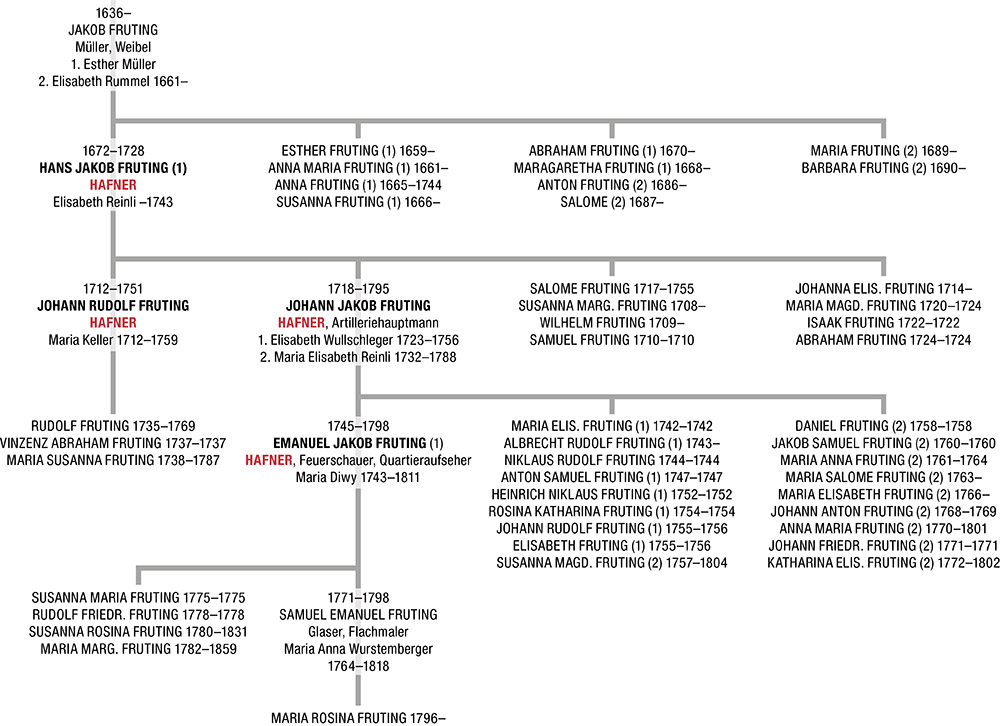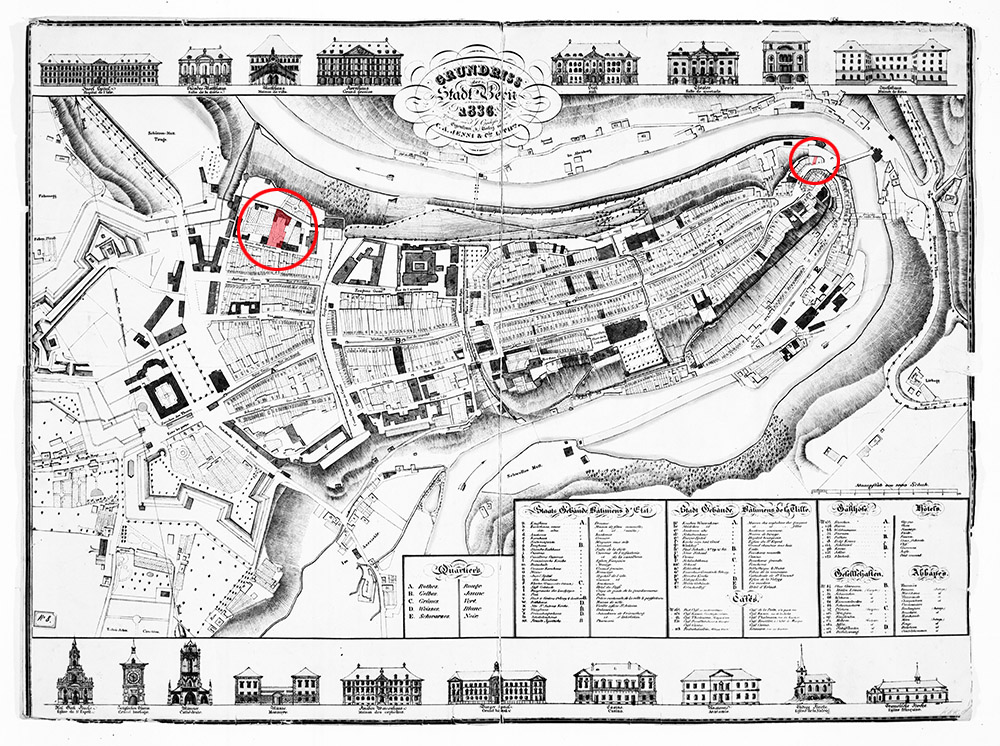
Potter Emanuel Jakob Fruting (1745–1798). Portrait by an unknown artist. Photo Jürg Bernhardt, Burgerbibliothek Bern, Neg. 5963, Porträtdok. 9757.
Andreas Heege, Andreas Kistler, Paul Dubs, 2025
The most recent comprehensive study on the Fruting family of potters from Bern was published by Adriano Boschetti in 2006 (Boschetti-Maradi 2006, 174–180). He based some of his research on previous studies by Walther A. Staehelin (Staehelin 1948. See also Staehelin 1947, 104). Recent genealogical research on Bernese family lineages necessitated minor changes to the dates of birth and death of some of the potters (see the family tree; the dates for all potters were taken from http://www.bernergeschlechter.ch and compared by Andreas Kistler with Bernese church records; Heege/Kistler/Dubs 2019).

Genealogy of the Fruting potters from Bern. Draft by Andreas Kistler, graphic representation Max Stöckli, artmax, Schwarzenburg.
Emanuel Jakob Fruting was the grandson of Hans Jakob Fruting, a Bernburger (citizenry of Bern) (12/1/1672-23/4/1728; Bernburger church records (hereinafter KRBB) 10, 18; KRBB register of deaths 1, 31.) and his wife, Elisabeth Reinli (?-9/10/1743). Hans Jakob was a member of the Pfistern Guild. He had many siblings. According to church records, his father, Jakob Fruting (1636–?), was a miller and bailiff. Hans Jakob’s godfathers included fairly important men such as treasurer Hans Jacob Bucher and one member each of the Diesbach and Wurstemberger families. We know that Hans Jakob Fruting made tiled stoves for the Insel Hospital in Bern, though none have survived (Hofer 1952, 413 fn. 2).
Hans Jakob Fruting (1672-1728) had ten children. Only one of the children’s godfathers had a background in pottery making; master potter David Benedikt (1677-1733) was godfather to Hans Jakob’s daughter Salome (1717-1755). The godfathers of the other children included only two members of the von Erlach family. Two of Hans Jakob Fruting’s sons also became potters: Johann (Hans) Rudolf Fruting (14/4/1712-10/6/1751; KRBB 12, 13; KRBB register of deaths 2, 137) and Johann Jakob Fruting (2/11/1718-14/3/1795; KRBB 12, 204; KRBB register of deaths 2, 102).
Evidence of Johann (Hans) Rudolf Fruting’s work history dates from 1750. Together with the potters Emanuel Hermann (1716-1778) and Wilhelm Emanuel Dittlinger (1718-1799), he fitted at least 20 sea green and white tiled stoves described as “Gupfenöfen, Kastenöfen oder Puffertöfen”, in other words, stoves with a tower or finial, box-shaped stoves or stoves in the form of a buffet or sideboard, for the Chapter of Canons on Münsterplatz square in Bern (see Brennpunkt 2013, 8, 12, 16; Biber/Hofer 1947, 222). Unfortunately, none of the stoves have survived. In the absence of a re-evaluation of the original sources (Hofer 1947, 390) we cannot say for certain if his brother, Johann Jakob, was also involved in their making. Rudolf (25/8/1735-January 1769) was the only one of Johann (Hans) Rudolf Fruting’s sons to survive into adulthood; it is not known if he ever worked in the pottery industry.

Map of the city of Bern from 1836 with the Fruting potters’ properties marked in red. No. 4 on the left, on Vordere Speichergasse lane in the ‘Red Quarter’, no. 2 on the right, on Nydeggstalden in the ‘White Quarter’. Source of the map: Burgerbibliothek Bern Kart III, 19b.
Johann Jakob Fruting (1718-1795) had a workshop on Vordere Speichergasse in Bern (no. 4, Red Quarter; cadastral register for Bern no. 4, 1783, 598 “hinter den Spicheren”. Cadastral register no. 7, 1795, 580: a two-storey, stone-built house with a basement, several outbuildings and a garden. Cadastral register no. 12, 1806, 385 mentions a potter’s workshop within the building). As many as three journeymen were in his employ in 1767. He had close ties to Adam Spengler, a pottery painter from Schaffhausen and the first director of the Frisching Faience Manufactory (Bösch 2003, 55–57; Heege/Spycher 2025). Fruting and the potter Wilhelm Emanuel Dittlinger both acted as godfather to one of Spengler’s sons in 1755. In the Bernese military, he rose to the rank of Captain of the Artillery (according to the cadastral register of Bern no. 5, 1786, 203).
Johann Jakob Fruting was married twice. His first wife was Elisabeth Wullschleger (1723-23/2/1756, from Zofingen); he married his second wife, Maria Elisabeth Reinli (1732-28/11/1788, from Aarburg) on 24th September 1756. He had nine children with his first wife, though none of them survived into adulthood. His second marriage produced ten children, and all four sons died in infancy. Most of his children’s godfathers were tradesmen (bakers, stonemasons, blacksmiths, coopers, farriers, butchers and painters and decorators), but only one potter is mentioned: “Master Anthoni Herman” (Johann Anton Hermann, 1721-1778) was Anton Samuel’s (1747-1747; KRBB 14, 17) godfather. Apparently, Johann Jakob worked into old age or was at least still in charge of taking commissions. We know, for instance, that he was paid 3 Kronen and 23 Batzen to repair the Kunstofen (a small tiled stove heated by the exhausts from the main stove) and all other stoves at Aarberg Castle in 1794 (State Archive of Bern (hereinafter StAB) B VII Aarberg 867, 47).
Emanuel Jakob Fruting (see the portrait at the beginning) was the only surviving son of Johann Jakob Fruting. He was born on 17th June 1745 in Bern (KRBB 13, 512). In 1767, Johann Jakob purchased a house and potter’s workshop “on behalf of his son, Emanuel Jacob Fruting” facing onto the lane on the north side of Nydeggstalden in Bern. The workshop had previously been used by the late potter Anton Rudolf Küpfer (1723-pre 1767) (cadastral register of Bern, no. 2, 119). The record explicitly states that the house included “a large lower section with a potter’s mill installed within it”. The neighbouring house to the west was owned by grocer and vintner Stürler. The property was bounded to the north by the ring wall. The property was bought for 1500 Bernese Kronen, though with an extremely high mortgage of 1289 Bernese Kronen. The remaining sum of 211 Kronen was not paid either but considered a loan subject to interest. The record of another loan of 300 Kronen that Emanuel applied for in 1769 also informs us that his neighbour to the east was spice trader Wagner and that Emanuel’s house was therefore not the last one on Nydeggstalden (cadastral register of Bern, no. 2, 424. A portrait of spice trader Wagner and his wife can be found in Howaldsche-Brunnenchronik, Burgerbibliothek Bern Mss hh XXIb 362, XV).
Etched glass coat of arms of Emanuel Jacob v. Fruting and his wife Maria Magd. Diwj, 1792. Photo by Yvonne Hurni, Bernisches Historisches Museum Inv. Nr. 22201.
On 30th December 1767, Emanuel Jakob Fruting joined the “zum Affen” Guild and received a “membership certificate” (Staehelin 1948, 42). On 8th January 1768, he married Maria Magdalena Diwy (1743-1/9/1811) in Belp. She was the daughter of the Reverend Johann Jakob Diwy (from Bern) and Rosina Reinli (from Aarburg). The marriage is attested to by an etched glass coat of arms. Its inscription reads: “Master Emanuel Jakobh v. Fruting Citizen and Fire Warden of Bern, Mistress Maria Magd. Diwj 1792”. It shows that the Frutings, though “ordinary citizens”, belonged to a select group of Bern burghers who were allowed to use “von” like the more important, patrician families (personal communication from Manuel Kehrli, Zimmerwald. Cf. Kehrli 2008, 208). The etched glass also tells us that Fruting was the holder of a minor public office in 1792, that of public fire warden for the fourth quarter of the city in the area of the old Nydegg Castle and Matte quarter. The records for 1794, 1796 and 1797 describe him as an overseer of two fire wardens (Regimentsbuch der Republik Bern 1794, 61; 1796, 62; 1797, 62). This office may have been what inspired Fruting to wear a kind of uniform when he had his portrait painted, which did not, however, correspond to any of the Bernese military uniforms of the period (on Bernese uniforms see Heege/Kistler/Thut 2011, 163–167; Heege/Kistler 2017, 429–433).
Remarkably, Emanuel Jakob sold his house to his father, Johann Jakob Fruting, for 1200 Kronen in April 1778. The sum just about covered the outstanding mortgage on the house and the interest that had accumulated, so that Emmanuel Jakob received only 1 Krone and 2 Batzen. The contract, however, stipulated that the house would not be valued at more than 1200 Kronen when it came to dividing his father’s assets between him and his siblings after the father’s demise (cadastral register no. 4, 90–91). In May 1794, the contract was cancelled because he bought the house back, but this was not recorded in the register until 5th June 1795, three months after his father had died (cadastral register no. 6, 602–603).
In March 1787, Emanuel Jakob bought a house with a small garden in the Matte quarter at auction for just 135 Kronen (cadastral register no. 5, 285–287). A year later, he bought a property known as “Pfizbad” located “in the city of Bern at the very top of the Matte quarter”, which consisted of a residential building, a “Stöckli” or small outhouse, bath houses on the River Aare and a terraced garden plot for 4500 Kronen (cadastral register no. 5, 422–423). Following his father’s death (14/3/1795), the estate was divided among Emanuel Jakob and his surviving five stepsisters on 21st September 1795 (see the family tree; cadastral register of Bern no. 7, 579–599). With the paternal and maternal heritage separated, the father’s assets amounted to just under 16,000 Kronen, which were then divided among his heirs. Emanuel Jakob inherited the house on Vordere Speichergasse, which was valued at 5100 Kronen. This meant that he had to pay his five sisters just over 3000 Kronen. Remarkably, none of the records make any mention of the father’s workshop.
Emanuel Jakob Fruting and Maria Diwy had five children, two of whom died in infancy (see the family tree). The only surviving son, Samuel Emanuel Fruting (born on 19th May 1771 in Bern) was a glazier and painter and decorator (contrary to Boschetti-Maradi 2006, 174 and 179, there was no son by the name of Johannes Fruting. For genealogical reasons, the official accounts cited by Boschetti-Maradi can clearly be attributed to Emanuel Jakob Fruting’s father or to Emanuel Jakob himself. Original records assessed by Andreas Heege in January 2018). Samuel Emanuel married Maria Anna Wurstemberger (1764-28/2/1818) on 20th February 1796. He died on 5th March 1798 fighting the French at the Battle of Neuenegg.
Hardly anything is known about the ceramic products made by Emanuel Jakob Fruting. Written records show that he fitted or repaired stoves and tiled stoves in the Canton of Bern from 1791 onwards. Because there is no evidence of any commissions prior to that date, it is highly unlikely that he took over his father’s business in 1767, as stated by Staehelin (1947, 104), since we can show that his father continued to work until 1794. Moreover, Emanuel Jakob is known to have worked at his own premises on Untere Nydeggstalden from 1767 onwards.
The first confirmed record of Emanuel Jakob’s work dates from 1791 at Aarberg Castle: “Potter Emanuel Jacob Frutig in Bern, fitting of the Kunstofen and roasting stove with five pots, inserting four stoke holes in the stoves, travel expenses, 12 Kronen 20 Batzen” (StAB B VII 864, 23. Staehelin 1948, 42 fn. 13 – for 1790 – does not refer to Fruting but to master potter Schneider from Wiedlisbach). The 1791 and 1795 records for Prebend House in Trub simply contain the information: “Master Frutig, the potter”, Kunstofen stove 33 Kronen 19 Batzen (StAB B VII 2081a, 57) and “Master Frutig in Bern”, repairs 2 Kronen, 7 Batzen 2 Kreuzer (StAB BVII 2086, 68). Given that Johann Jakob Fruting died on 17th March 1795, it is likely that at least the second entry referred to Emanuel Jakob. The first entry could have referred to either of them. In 1794, Emanuel Jakob, entitled “Master Frutig jun.” (his father was still alive at that time), contributed a “Kunstofen and roasting stove” to the Neue Münze building project for 6 Kronen 10 Batzen (Biber/Hofer 1947, 254). In 1797, “Master Fruting, potter Bern” “improved” the Kunstofen in the Aarberg Castle kitchen for 18 Batzen. The ironsmith Johannes Peter also fitted a ring around the iron pot in the Kunstofen (StAB B VII Aarberg 870, 37 and 38). That same year Emanuel Jakob was paid 53 Kronen to install “a roasting Kunstofen with a copper teapot, three iron pots, a roasting pan and two trays” at the rectory in Kallnach (StAB B VII Aarberg 870, 46. Boschetti-Maradi 2006, 174 and 179).
None of these stoves have survived. Nor do we know of any signed tiles made by Emanuel Jakob Fruting. In view of his period of production, we can probably assume that he made typically Bernese late Rococo stoves with blue or manganese purple decorations, or perhaps early monochrome white or sea green box-shaped or cylindrical stoves in the Neoclassicist or Empire styles (see e.g. the tiled stoves made by Daniel Herrmann, 1736–1798, in Langnau or the stoves made by the Staub potters from a similar period in Langenthal: Heege/Kistler 2017, 456-485; Heege 2011, 242-281). It is a distinct possibility that the well-known Bernese stove painter Peter Gnehm (1712-1799) worked for Fruting, although there is no conclusive evidence to confirm it, despite what some researchers believe.
Since 1948, a small faience jug which is typologically quite unusual and which bears the coat of arms of the Bonstetten family from Bern and the mark “EIF”, has been attributed to Emanuel Jakob Fruting by various authors (Boschetti-Maradi 2006, 179–180 with earlier references; Boschetti-Maradi 2007, 26–27). However, doubts regarding its authenticity have recently been raised (Ducret 2012, 43 Fig. 4).
 Berner Wochenblatt, Nummer 42, 20. Oktober 1798
Berner Wochenblatt, Nummer 42, 20. Oktober 1798
Emanuel Jakob Fruting died on 12th October 1798. We have no records of how his estate was distributed among his heirs. On 10th February 1804, Maria Diwy, the widow of the late potter and local overseer, sold the house and property on Nydeggstalden “No. 2, white quarter”, which was then being described as adjoining Lengmauerweg lane to the north (cadastral register of Bern, no. 11, 116–120), and held onto the considerably larger house, courtyard and workshop of her father-in-law in the Red Quarter, no. 4, on Vordere Speichergasse (cadastral register no. 12, 384–388). This property was eventually sold by Maria Diwy’s three heirs on 31st August 1811 (cadastral register no. 14, 388-394).
The Bernese surname Fruting ceased to exist in 1801, when the notary Daniel Fruting (26/2/1740–18/8/1801), a member of a distantly related branch of the family died (http://www.bernergeschlechter.ch/humo-gen/family.php?database=humo_&id=F31378&main_person=I91914. Allgemeine Geschichtsforschende Gesellschaft der Schweiz (ed.), Historisch-Biographisches Lexikon der Schweiz, vol. 3, 1934, 351). His father, Petermann Fruting, had previously served as a pastor’s assistant in Trubschachen and as a parish priest in Vechigen.
Translation Sandy Haemmerle
References:
Biber, W. & Hofer, P. (1947): Regesten zur Baugeschichte stadtbernischer Staatsbauten des 16.–18. Jahrhunderts, Bd. I. Bern.
Bösch, F. (2003): Zürcher Porzellanmanufaktur 1763–1790, Porzellan und Fayence, Bd. 1 und 2. Zürich.
Boschetti-Maradi, A. (2006): Gefässkeramik und Hafnerei in der Frühen Neuzeit im Kanton Bern. Schriften des Bernischen Historischen Museums 8. Bern.
Boschetti-Maradi, A. (2007): Geschirr für Stadt und Land. Berner Töpferei seit dem 16. Jahrhundert. Glanzlichter aus dem Bernischen Historischen Museum 19. Bern.
Brennpunkt (2013): Schloss Jegenstorf (Hrsg.), Im Brennpunkt – die Sammlung historischer Kachelöfen Schloss Jegenstorf. Jegenstorf.
Ducret, P. (2012): Schweizerische Fayencen des 18. Jahrhunderts in Scharffeuerfarben bemalt. Keramikfreunde der Schweiz, Mitteilungsblatt 125, 2012, 42–50.
Heege, A. (2011): Langenthal, St. Urbanstrasse 40–44. Die Hafnerei Staub und ihre Werkstatt. Archäologie Bern/Archéologie bernoise. Jahrbuch des Archäologischen Dienstes des Kantons Bern 2011, 209–287.
Heege, A. & Kistler, A. (2017): Keramik aus Langnau. Zur Geschichte der bedeutendsten Landhafnerei im Kanton Bern. Schriften des Bernischen Historischen Museums 13. Bern.
Heege, A., Kistler, A. & Thut, W. (2011): Keramik aus Bäriswil. Zur Geschichte einer bedeutenden Landhafnerei im Kanton Bern. Schriften des Bernischen Historischen Museums 10. Bern.
Heege, A., Kistler, A., Dubs, P. (2019): Emanuel Jakob Fruting – Ein neues Porträt eines bernischen Hafners, in: Keramikfreunde der Schweiz Mitteilungsblatt Nr. 133, 2019, 125-131.
Heege, A., Spycher, A. (2025): Ein Kachelofen aus Schloss Oberhofen – Wer ist «ASP»?, in: Keramikfreunde der Schweiz, Revue 140, 2025, 103-126.
Hofer, P. (1947): Die Kunstdenkmäler des Kantons Bern, Die Stadt Bern, Bd. 3, Die Staatsbauten. Die Kunstdenkmäler der Schweiz 19. Basel.
Hofer, P. (1952): Die Kunstdenkmäler des Kantons Bern, Die Stadt Bern, Bd. 1, Stadtbild, Wehrbauten. Die Kunstdenkmäler der Schweiz 28. Basel.
Kehrli, M. (2008): Patriziat, Briefadel und Titulaturen. In: Holenstein, A. (Hrsg.), Berns goldene Zeit. Das 18. Jahrhundert neu entdeckt. Bern, 209.
Staehelin, W.A. (1947): Keramische Forschungen in bernischen Archiven. Zeitschrift für Schweizerische Archäologie und Kunstgeschichte 1947, Heft 9, 101–118.
Staehelin, W.A. (1948): Keramische Forschungen in bernischen Archiven II. Die Fayencewerkstätte des Emanuel Jakob Fruting in Bern (1745–98). Freunde der Schweizer Keramik, Mitteilungsblatt 8, 41–43.


